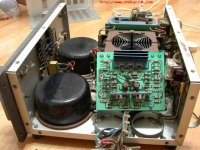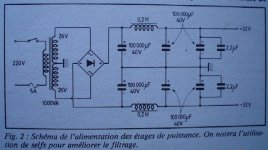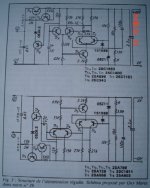Guys much of the things discussed are subjective but these are my thoughts as to why separate supplies are better:
When the output drives a non resistive load ie a speaker, there is a great demand for current etc. Speakers are reactive and can present an impedance of less than two ohms when driven hard. This presents a large demand on the power supply and may “de-stabilise’ the front end of your amp.
If you have a separate, properly designed power supply for the front end you can avoid these problems and reduce hum/ ripple / distortion etc.
When I get my 4 PCB’s from Mark, I will build one amp with separate power supplies and one without to compare. Also I will compare one large filter cap against many smaller ones.
There is an interesting article in the September Audio Express magazine in building a class A amp using some of the principles discussed.
Regards
Harry
When the output drives a non resistive load ie a speaker, there is a great demand for current etc. Speakers are reactive and can present an impedance of less than two ohms when driven hard. This presents a large demand on the power supply and may “de-stabilise’ the front end of your amp.
If you have a separate, properly designed power supply for the front end you can avoid these problems and reduce hum/ ripple / distortion etc.
When I get my 4 PCB’s from Mark, I will build one amp with separate power supplies and one without to compare. Also I will compare one large filter cap against many smaller ones.
There is an interesting article in the September Audio Express magazine in building a class A amp using some of the principles discussed.
Regards
Harry
Harry3 said:Guys much of the things discussed are subjective but these are my thoughts as to why separate supplies are better:
When the output drives a non resistive load ie a speaker, there is a great demand for current etc. Speakers are reactive and can present an impedance of less than two ohms when driven hard. This presents a large demand on the power supply and may “de-stabilise’ the front end of your amp.
Not in a properly dimensioned and biased class A amp, they won't. For my KSA 100 clone (in reality de-tuned KMA200) unless I'm at headbanging levels with 15" drivers in friend's ATCs (all other drivers I tried bottom out way before amp clips), current draw is not changing one bit with program. Have a look one day at Pass X amps - they actually have current meter at the front. Unless at SERIOUSLY party levels the needle doen't move regardless of material or speakers attached. And at those levels believe me your ears will be distorting a lot more than amp's front end !
😀 😀 😀
Harry3 said:Guys much of the things discussed are subjective but these are my thoughts as to why separate supplies are better:
When the output drives a non resistive load ie a speaker, there is a great demand for current etc. Speakers are reactive and can present an impedance of less than two ohms when driven hard. This presents a large demand on the power supply and may “de-stabilise’ the front end of your amp.
If you have a separate, properly designed power supply for the front end you can avoid these problems and reduce hum/ ripple / distortion etc.
When I get my 4 PCB’s from Mark, I will build one amp with separate power supplies and one without to compare. Also I will compare one large filter cap against many smaller ones.
There is an interesting article in the September Audio Express magazine in building a class A amp using some of the principles discussed.
Regards
Harry
Due to the already heavy demand caused by class-A biasing, as power goes up, demand does not go up proportionally. (Actually dissipation goes down.) WHat you say holds true more for a class-AB amplifier.
And as mentioned before, do not let Ampguru hit you with one of his, "Greg Ballz of fire!".
awpagan said:If current is set, what is the gain of massive caps?
just to filter ripple or provide extra current when needed?
I don't understand the question. How can you have even remotely resembling DC without large caps ?
As far as "extra current", again there is no extra current with class A amps. That is the wholle point - you draw at idle maximum current (*) you anticipate you will ever need. As soon as you need "extra" you are not in class A anymore.
I thought this was rather obvious ? At least to people in this thread ?
Bratislav
(*) or half that in push pull configuration like KSA50 discussed
Thank you for the theoretical lesson in class A amplification.
If you believe that your power supply will remain stable driving a complex load like a speaker and that Nelson is God fine by me. Who am I to argue, but I will be using regulated power supplies for the front end and I’ll turn up the volume so you can hear it all the way down in Melbourne. Have a good weekend.
🙂
If you believe that your power supply will remain stable driving a complex load like a speaker and that Nelson is God fine by me. Who am I to argue, but I will be using regulated power supplies for the front end and I’ll turn up the volume so you can hear it all the way down in Melbourne. Have a good weekend.
🙂
Hi K-amps,
.... "And as mentioned before, do not let Ampguru hit you with one of his, "Greg Ballz of fire!"."....
Please elaborate.
some baseless misinformation going down here.
Cheers,
Greg
.... "And as mentioned before, do not let Ampguru hit you with one of his, "Greg Ballz of fire!"."....
Please elaborate.
some baseless misinformation going down here.
Cheers,
Greg
Harry3 said:If you believe that your power supply will remain stable driving a complex load like a speaker and that Nelson is God fine by me. Who am I to argue, but I will be using regulated power supplies for the front end and I’ll turn up the volume so you can hear it all the way down in Melbourne. Have a good weekend.
🙂
Good on you (glad I'm not a neighbour) 😎
I never said Nelson is God (although he's got a good case 😉 ).
As far as complex loads, if current meter is not registering changes please give the explanatory mechanism on how can supply current vary ? I know some speakers drop to less than 2 ohms (ESLs especially) but I will also tell you that if I pumped 6A through them at 10KHz (as to leave my class A region) they won't survive to tell the story later. Yes some crappy speaker designs will drop that low in the bass region, but again not many woofers will live to tell (most will hit displacement limits at mid-low bass with as little as 50W - see measurements and estimates of the mighty Peerless XLS at Likwitz's site under Thor subwoofer).
Even if they do - have you seen distortion figures of even world' best drivers at those levels ? Under 10% is considered GOOD !
I have tested my Krell clone with standard R || C (3.3 ohm paralel with 1uF) during stability testing with a squarewave signal, and this was at almost full power (that is I was leaving class A at 40+V p-p) . Couldn't detect anything apart from slight overshoot and couple of cycles, well damped. As expected. I also tested it at clipping (THAT will stress power supply for sure!) and no sign of stiction at all, just a clean, symmetrical textbook clip. I gradually reduced the output stage negative feedback (not using any now, output TO3s are completely outide the feedback loop). I've even removed the R/C Zobel (5.6 Ohm/100nF). (I have speaker protection though that detects any HF over few watts at 20KHz and above. It never triggers except with a few crappy badly clipped CDs).
I even tested it at 1 ohm and it pumped out almost 1.3KW (50A p-p - that test was quite short 🙂 )
Never ever missed the bit, sounded harsh, constrained or distorted.
Now, it is quite possible that it could be even better with a regulated front end - and as I already said several times, it surely cannot make it worse.
I just thought that extra money was better spent elsewhere (yes including live concerts, CDs, booze or all of the above 😀 )
Have a good one.
Hi Bradislow,
You're absolutely correct. Crappy speakers that drop below 3/4 of the rated impedance, show incompetence of design.
Amplifiers that REQUIRE more than reasonable PS capacitance to function at all well are also crappy designs. Ones that NEED their ripple reduced below input signal level or beyond 'VA need' reg are also poorly designed needing a cover up. To concoct absurd drive requirement is folly. Best to improve the design for cents than salve it with absurd and monstrous overbuilding. Then celebrate the monstrosity of it all.
Honestly has anybody heard a Krell not at it's best on a requiem? There's something in that for all of us.
Cheers,
Greg
You're absolutely correct. Crappy speakers that drop below 3/4 of the rated impedance, show incompetence of design.
Amplifiers that REQUIRE more than reasonable PS capacitance to function at all well are also crappy designs. Ones that NEED their ripple reduced below input signal level or beyond 'VA need' reg are also poorly designed needing a cover up. To concoct absurd drive requirement is folly. Best to improve the design for cents than salve it with absurd and monstrous overbuilding. Then celebrate the monstrosity of it all.
Honestly has anybody heard a Krell not at it's best on a requiem? There's something in that for all of us.
Cheers,
Greg
Hi,
The current on the rails follows the sinusoidal waveform of the signal.
Of all the many and various topologies adopted for ClassA I have seen only one that is genuinely of constant current draw. That particular single ended topology is very rare indeed. and certainly not in the KSA Klone.
Allowing for that misconception, it might be easy to fall for the notion that speed is not required.
But if you want the rails to be apparently stiff with respect to the highest frequecies that the amp is asked to amplify, I would think that the regulator needs to be faster than the amplified signal.
In general classA amps DO NOT have constant current draw.Why do you need speed in a regulator when current draw from the amp is as constant as it gets (after the initial surge) ?
The current on the rails follows the sinusoidal waveform of the signal.
Of all the many and various topologies adopted for ClassA I have seen only one that is genuinely of constant current draw. That particular single ended topology is very rare indeed. and certainly not in the KSA Klone.
Allowing for that misconception, it might be easy to fall for the notion that speed is not required.
But if you want the rails to be apparently stiff with respect to the highest frequecies that the amp is asked to amplify, I would think that the regulator needs to be faster than the amplified signal.
Hugh, don't ask Greg, what he's really think... 😉 ( Maybe he can't to take to children toy.... ) 😉
AndrewT,
Which probably dictates that the series pass on the regulator should be an emitter follower with very fast error correction to the base.......
Cheers,
Hugh
Which probably dictates that the series pass on the regulator should be an emitter follower with very fast error correction to the base.......
Cheers,
Hugh
Aah, the cavalry has arrived, even 3 of them.
If your religion is audio, Pass definitely is god.
(some of his groupies even read every article to find out what that gourmand favored for lunch)
I tend to agree with Bratislav that there is less to be gained by separating powersupplies and/or using regulation on a class A amplifier with a high bias and a very sturdy powersupply that is able to keep voltage ripple low.
AmpGuru is also right in the Ball-park that designs needing to rely on heavy powersupplies for PSRR reasons are poorish designed.
If the lord humungous amplifier Bratislav posted keeps ripple low without a entry signal, fully driven the powersupply has an easier job.
But i don't think most of the Krell builders here are building derated KSA200s. A number of them do not intend to run their KSA50 in full bias, and the original KSA50 wasn't.
My bias target is 7 amps, even with a CLC the voltage ripple will not be pretty. The ripple on the output stage is not a concern, by using separate powersupplies the front end will be totally independant of the bias level.
With exception of a few like Jacques Mahul's, the gorgeous loudspeaker systems i've seen and heard over the last decennia need to rely on very chunky amplifiers.
It's a shame the French L'Audiophile(Jean Hiraga) magazine was never published in English. That published the first regulator circuits in the late 70s, the regulator of the Japanese gentleman Akihito Kaneda was the official first i believe. The magazine published a lot of class A designs, some 15 years ago even fully regulated ones( By the mystery designer Hephaistos).
All those designs used CLC, CRC, huge transformer and capacitor banks from the start.
Here's looking at you kid, 50 watts class A, separate powersupplies with front end regulation (1988):
Bratislav said:I never said Nelson is God
If your religion is audio, Pass definitely is god.
(some of his groupies even read every article to find out what that gourmand favored for lunch)
I tend to agree with Bratislav that there is less to be gained by separating powersupplies and/or using regulation on a class A amplifier with a high bias and a very sturdy powersupply that is able to keep voltage ripple low.
AmpGuru is also right in the Ball-park that designs needing to rely on heavy powersupplies for PSRR reasons are poorish designed.
If the lord humungous amplifier Bratislav posted keeps ripple low without a entry signal, fully driven the powersupply has an easier job.
But i don't think most of the Krell builders here are building derated KSA200s. A number of them do not intend to run their KSA50 in full bias, and the original KSA50 wasn't.
My bias target is 7 amps, even with a CLC the voltage ripple will not be pretty. The ripple on the output stage is not a concern, by using separate powersupplies the front end will be totally independant of the bias level.
With exception of a few like Jacques Mahul's, the gorgeous loudspeaker systems i've seen and heard over the last decennia need to rely on very chunky amplifiers.
It's a shame the French L'Audiophile(Jean Hiraga) magazine was never published in English. That published the first regulator circuits in the late 70s, the regulator of the Japanese gentleman Akihito Kaneda was the official first i believe. The magazine published a lot of class A designs, some 15 years ago even fully regulated ones( By the mystery designer Hephaistos).
All those designs used CLC, CRC, huge transformer and capacitor banks from the start.
Here's looking at you kid, 50 watts class A, separate powersupplies with front end regulation (1988):
Attachments
oops,
i hope i didn't say something controversal 🙂
now we have the general idea, my daddies better than yours?
The only reason i asked was because of the price of the caps.
and no not for commercial use, i can see the reasoning.
At present i have a couple of reg'd psu's dual mono, that i hope to
try.
when possible i'll see about large caps.
could be interesting to hear any difference or not?
allan
i hope i didn't say something controversal 🙂
now we have the general idea, my daddies better than yours?
The only reason i asked was because of the price of the caps.
and no not for commercial use, i can see the reasoning.
At present i have a couple of reg'd psu's dual mono, that i hope to
try.
when possible i'll see about large caps.
could be interesting to hear any difference or not?
allan
awpagan said:my daddies better than yours?
If yours is still alive, you win.
jacco
If yours is still alive, you win.
he is, awesome, finally won something
Will have to try Lotto in morning😀
allan
If yours is still alive, you win.
he is, awesome, finally won something

Will have to try Lotto in morning😀
allan
Upupa Epops said:...( Maybe he can't to take to children toy.... ) 😉 ....
Hey, that insult resembles me.

- Home
- Amplifiers
- Solid State
- Krell KSA 50 PCB



